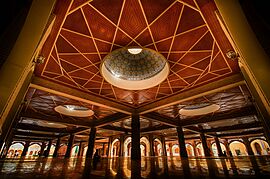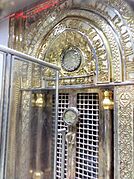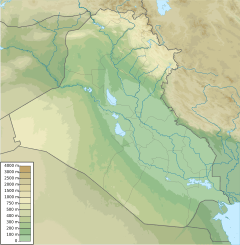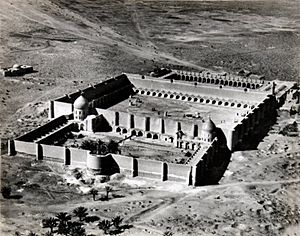Kufa facts for kids
Quick facts for kids
Kufa
الْكُوفَة
|
|
|---|---|
| Country | |
| Governorate | Najaf |
| Population | |
| • Total | 230,000 |
| Time zone | GMT+3 |
Kufa (Arabic: الْكُوفَة “al-Kūfah”), also spelled Kufah, is an important city in Iraq. It is about 170 kilometres (110 mi) south of Baghdad. You can find it about 10 kilometres (6.2 mi) northeast of Najaf. The city sits right on the banks of the Euphrates River. In 2003, about 110,000 people lived there. Today, Kufa and Najaf have grown together into one big city area. Most people outside of Iraq know this area as 'Najaf'.
Kufa is one of five Iraqi cities that are very important to Shi'ite Muslims. The others are Samarra, Karbala, Kadhimiya, and Najaf. Kufa was founded in 638 CE. This was during the time of Umar ibn Al-Khattab, who was the second leader of the Rashidun Caliphate. Kufa became the final capital for the last Rashidun Caliph, Ali ibn Abi Talib. It was also the first capital of the Abbasid Caliphate. During the Islamic Golden Age, Kufa was famous for its language experts, called the grammarians of Kufa. The special writing style called Kufic script is named after the city.
Contents
History of Kufa
Kufa has a long and interesting history. It played a big role in early Islamic times.
How Kufa Was Built
After the Battle of Al-Qadisiyyah in 636 CE, the Arabian army won against the Persian Empire. Kufa was founded around 637–638 CE. It was built at the same time as another city called Basra. Both Kufa and Basra were important military cities in Iraq. They served as army bases and centers for government.
A companion of the Prophet, Sa`d ibn Abi Waqqas, started Kufa as a camp next to the old Arab city of Al-Hirah. It grew into a city with seven main parts. People from outside Arabia sometimes called it Hīrah or Aqulah. In 640 CE, the leader Umar moved Jewish people from Khaybar to Kufa.
Later, some people in Kufa were unhappy with how their governor was sharing war treasures. In 642 CE, Umar removed the governor to make people happy. He tried a few other governors, but the people of Kufa were hard to please. Finally, they agreed on Mughira ibn Shu'ba.
The city was planned in a circular shape. This design was common in ancient Persian buildings.
Kufa During Uthman's Rule
After Umar passed away in 644 CE, the new leader, Uthman, changed Kufa's governor. He appointed Al-Walid ibn Uqba in 645 CE. Around 650 CE, Uthman reorganized the areas under Muslim control. Kufa and Basra both got new governors.
However, some people in Kufa continued to cause trouble. In 654 CE, they managed to get their governor removed. They were happy when Abu Musa al-Ash'ari returned as governor. Uthman agreed to this to keep everyone calm. Even so, Kufa remained a place where small groups stirred up problems.
Kufa as Ali's Capital
When Caliph Uthman was killed, the governor Abu Musa tried to keep peace in Kufa. Muslims everywhere supported Ali ibn Abu Talib to become the next Caliph. To better manage the army and borders, Ali moved the capital from Medina to Kufa.
However, the governor of Syria, Muawiyah I, wanted justice for Uthman's death. He refused to accept Ali as Caliph unless Ali punished Uthman's killers first. This disagreement led to a war between Ali and Muawiyah.
While praying in the Great Mosque of Kufa, Ali was attacked by a man named Abd-al-Rahman ibn Muljam. He was hurt by a poisoned sword during his morning prayer.
Kufa Under Umayyad Rule
After Ali, Muawiyah I became the leader. He appointed Ziyad ibn Abihi as the Governor of Kufa. This happened after Hasan ibn Ali moved to Medina, following a peace agreement. Some of Hasan's followers were not happy with this agreement. They continued to oppose the new ruler. Ziyad ibn Abihi was a clever leader and managed to stop these rebellions.
Rebellions in Kufa
Throughout the Umayyad period, many people in Kufa were rebellious against their rulers. When Yazid I became the second Umayyad Caliph, some Kufans rebelled. They asked Muhammad's grandson, Husayn ibn Ali, for help. Yazid sent Ubayd Allah ibn Ziyad to Kufa to stop the rebellion. This led to the tragic Battle of Karbala, where Husayn was killed. There was a short period of peace when Al-Mukhtar ruled. Also, during the time of Governor Al-Ḥajjāj ibn Yūsuf, Kufa was calmer.
Kufa in the Abbasid Era
In 749 CE, the Abbasids took control of Kufa and made it their capital. Their leader was al-Hasan ibn Qahtaba. However, in 762 CE, they moved their main city to Baghdad. Over time, Kufa became less important for political power. Instead, it became a center for Islamic learning and ideas.
The city was attacked and damaged by a group called the Qarmatians in 905, 924, and 927 CE. Kufa never fully recovered from this destruction.
Kufa's Role in Islamic Learning
Kufa was a very important place for Islamic studies. Unlike some other cities, Kufa didn't have many people who had lived with Prophet Muhammad. So, scholars in Kufa relied on the teachings of Muhammad's companions who settled there.
One important scholar, Abu Hanifa, lived in Kufa. He helped start one of the main schools of Islamic law, called the Hanafi school. Many other Kufan scholars helped develop and defend his ideas.
Kufa was also home to many famous Islamic legal experts. Out of 84 important early legal scholars, 20 came from Kufa. This shows how important the city was for Islamic law. Some of Muhammad's most famous companions lived in Kufa, like Abd Allah ibn Mas'ud and Salman the Persian.
Important religious leaders like Imam Muhammad al-Baqir and his son Jafar al-Sadiq also influenced Kufa's laws. Even today, Shi'ite law follows their examples. Abu Hanifa also learned from these Imams. Because of this, Hanafi law is quite similar to Shi'ite law in many ways.
Kufa was one of the first places where people studied and explained the Qur'an. It also collected many sayings and actions of the Prophet, known as Hadith.
Because Kufa often disagreed with the rulers in Damascus, Kufan historians had their own way of writing about history. A historian named Abu Mikhnaf collected these stories. Even though his original writings are lost, later historians like Tabari used them a lot.
Kufa is also where the Kufic script was created. This was the earliest form of writing for the Arabic language. It was a very angular and decorative style. It became very popular for decorating buildings and objects. Many famous language experts, called grammarians, came from Kufa. They had a famous rivalry with the grammarians from Basra.
Kufa After the Abbasids
Kufan coins have been found far away, even in northern Russia. This shows that Kufa had wide trading connections a long time ago.
Kufa began to be attacked often in the 11th century. It slowly became smaller and less important. However, in the last century, Kufa's population has started to grow again. It remains a very important place for Shi'ite Muslims to visit.
Geography of Kufa
Kufa is located on the banks of the Euphrates River. It is about 170 kilometres (110 mi) south of Baghdad. The city is also about 10 kilometres (6.2 mi) northeast of Najaf.
Religious Importance
Kufa is a very special place for Shi'ite Muslims. Many important Shi'ite scholars have come from this town. It also has several important religious buildings:
- The Great Mosque of Kufa was built in the mid-7th century. It holds the remains of Muslim ibn Aqeel, who was a cousin of Husayn ibn Ali. It also contains the tomb of his friend Hani ibn Urwa and the revolutionary Al-Mukhtar. The mosque has many important spots related to prophets and Ali ibn Abi Talib. This includes the place where Ali was fatally struck on the head while praying.
- Ali's house, where he lived.
- The tomb of Zayd ibn Ali.
- Al-Hannanah Mosque, which is said to contain some skin from Husayn, taken after his death.
- The tomb of Maytham al-Tammar.
- The tomb of Kumayl ibn Ziyad.
- Al-Sahlah Mosque, which is linked to the Twelfth Imam of the Twelver Shia.
Culture and Sports
Sports in Kufa
Kufa has its own football team called Al-Kufa SC. They play in the second division of Iraq's football league. Their home games are played at the An-Najaf Stadium.
People Connected to Kufa
Many important historical figures have lived in or been connected to Kufa. Some of them include:
- Ali ibn Abi Talib
- Husayn bin Ali
- Muslim ibn Aqeel
- Mukhtar al-Thaqafi
- Yaqub ibn Ishaq al-Kindi
- Abu Hanifa
- Sufyan al-Thawri
- Abd Allah ibn Mas'ud
- Jabir ibn Hayyan
- Al-Kindi
See also
- Al-Hirah
- Great Mosque (Kufa)
- Shiism







